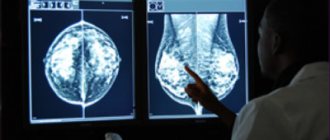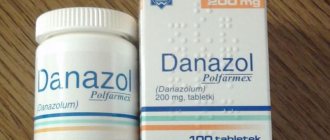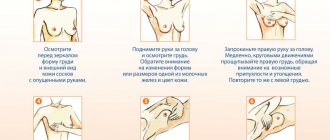What's happened
Adenosis is a benign neoplasm that is dependent on the level of hormones in the body. This, in turn, is confirmed by the manifestation of characteristic symptoms in the second phase of the menstrual cycle.
On this topic
- Breast
Can fibroadenoma hurt?
- Natalya Gennadievna Butsyk
- December 5, 2020
Most often, the disease is diagnosed in the female half of the population during reproductive age. Thus, in 30-70 percent of cases, pathology is detected in women between thirty and forty years old. If any gynecological pathological processes are present, then the likelihood of mammary adenosis increases to almost one hundred percent.
In addition, a similar condition can be observed in girls during puberty, when the menstrual cycle is just forming, as well as in women at the beginning of pregnancy. In such cases, adenosis is considered a physiological condition, since it has a predisposition to disappear on its own after a certain period of time.
As a rule, this happens after hormonal levels return to normal.
Reasons for development
The only and main provoking factor in the development of sclerosing adenosis is a hormonal imbalance, where there is an excess of estrogen and a deficiency of progesterone. Etiological factors that provoke hormonal imbalance include:
- Excess body weight. Excess adipose tissue produces estrogens, which leads to relative hyperestrogenism. In this case, the level of progesterone remains unchanged.
- Uncontrolled or prolonged use of hormonal oral contraceptives. Improper use of pills leads to hormonal imbalance and the development of dysplastic processes in the mammary glands.
- Artificial or spontaneous abortions. Termination of pregnancy, especially in the later stages, causes rapid hormonal changes in the body and disruption of compensatory mechanisms.
- Termination of lactation. An increased level of prolactin in the blood due to lack of lactation causes stagnation of milk in the ducts. This leads to their expansion and blockage, which entails structural changes, including the formation of cysts.
- Late pregnancy. In women after 35 years of age, ovarian activity begins to decline. If pregnancy occurs, their work is activated, which causes a postpartum failure in the synthesis of estrogen and progesterone.
- Postpartum agalactia indicates a deficiency of progesterone in the blood and an excess of estrogen. In this pathological condition, the stroma of the glands grows, and the lack of progesterone contributes to the uncontrolled growth of the glandular epithelium.
Breast adenosis is often diagnosed in women with diseases of the genitourinary system: endometriosis, uterine fibroids, ovarian tumors and endometrial hyperplasia.
Classification
Currently, experts identify several types of the disease. Each of the forms has its own distinctive features and characteristics.
Diffuse
The main difference between this form is that it does not have a clear location. It is for this reason that the tumor can grow over the entire surface of the breast tissue. In mammology, this type is the initial stage of the development of mastopathy.
During the formation of nodular formations, the structure of the ducts and glandular lobes may be disrupted. Over time, they develop into cystic tumors and larger nodules.
It is also worth noting that diffuse adenosis has a predisposition to rapid growth, as a result of which it degenerates into a focal type of pathology and can act as a provoking factor contributing to the formation of malignant tumors.
Local
Refers to the most common types of mastopathy. It is characterized by a lobed structural structure. In turn, the lobules can reach large sizes. Their cavity is surrounded by a capsule consisting of fibrous tissue.
It is also worth noting that the tumor formation has a clear localization. In addition, the pathology is accompanied by pronounced discomfort, and the compaction can be visualized against the background of the mammary gland.
Sometimes the process of proliferation can be accompanied by pain in the lymph nodes, felt in the armpits and under the mammary glands.
Apocrine
This type is characterized by the formation of nodules that have a configuration similar to the breast lobe. In this case, differentiated cells are replaced by other structures that have a similar structure.
Sometimes this form is mistaken for an infiltrating type of cancer process, despite the fact that it is benign in origin.
Sclerosing
The following clinical picture is characteristic of the sclerotic form:
- proliferation of pathogenic breast tissue;
- maintaining the integrity of the epithelium and myoepithelial layers of glandular lobules;
- compression of the acinus against the background of growth of nearby tissue structures.
On this topic
- Breast
Do lymph nodes enlarge with mastopathy?
- Natalya Gennadievna Butsyk
- November 29, 2020
In some cases, as the disease progresses, the integrity of the mammary gland ducts may be damaged, within which the formation of papillomas is noted. Such growths can grow over the tissues that line the ducts.
With the sclerosing type of breast adenosis, pain and heaviness are observed in the area of the mammary glands. Nearby lymph nodes may also enlarge.
Ductal
This form combines incorrectly formed ductal lobes. In this case, the layers lining the ductal structures begin to become overgrown with epithelial cells.
In other words, this type is essentially a sclerotic form, but the ducts appear without lobes. The pathological process has more pronounced symptoms and severe pain.
Adenomyoepithelial
It is a type of focal form. This type of disease is characterized by the formation of adenomyoepithelioma.
It is detected in relatively rare cases and is easy to diagnose.
Microgranular
It is also a rare type of disease. Characterized by diffuse growth of small ducts. In this case, there will be no compression or growth.
Experts also distinguish the tubular type of adenosis. The ducts contain a large number of microcalcifications and two layers of epithelial tissue.
Treatment methods
Much depends on the degree and form of pathology of the mammary glands. This is what doctors start from when selecting a method . Treatment of sclerosing adenosis of the mammary gland depends on the degree of development. But the sooner the problem is identified, the easier and faster it is to get rid of it. After all, sclerosis of the mammary gland is potentially dangerous.
In most cases, this disease of the mammary glands is detected in the early stages. Therefore, treatment is carried out using a conservative method. But with advanced variants, the patient cannot do without surgical intervention. The doctor excises the pathological tumor, while examining the tissue with an excisional biopsy.
In the conservative treatment of adenosis, several categories of drugs are used. This therapy helps to get rid of the problem qualitatively. It includes:
- multivitamin complexes
- antidepressants
- oral contraceptives
- hormonal drugs
Sometimes doctors supplement treatment with homeopathic remedies that have a good healing effect. In most cases, drug treatment for adenosis copes well with the problem. Self-prescribing the medicine is not recommended. This can worsen the problem and lead to the degeneration of cells into cancer.
In the medical treatment of breast adenosis, oral hormonal agents or a synthetic analogue of progesterone are used. This helps to take control of hormonal levels, level them out, and get rid of adenosis within a few months.
In addition to the main treatment, it is recommended:
- nutrition correction
- weight loss if necessary
- avoid stressful situations
- reduce physical activity
- monitor chronic diseases
- do not forget about timely rest
Sometimes sclerosing adenosis of the mammary gland is treated with folk remedies, supplementing the usual complex with them. For this, the folk method recommends using herbal products. They are taken orally, compresses are made using pumpkin seeds, cabbage or beets. Traditional recipes are not entirely suitable as a complete treatment for sclerosing adenosis of the mammary gland, but they can alleviate the patient’s condition. In addition, the use of folk remedies is harmless and does not produce side effects.
Causes
Among all the factors predisposing to the disease, experts highlight hormonal imbalances in first place. If the concentration of estrogen in a woman’s body increases, the glandular cells begin to grow rapidly.
The condition of the gland tissue also largely depends on prolactin and progesterone. The peak of hormonal changes occurs during puberty, as well as towards the end of reproductive age, that is, before the onset of menopause.
Often the development of pathology is noted during the period of bearing a child, which is also facilitated by an increased level of prolactin. With the onset of menopause, hormones begin to be produced at a slower pace. For this reason, adenosis in women is practically not diagnosed during menopause.
On this topic
- Breast
What breast fibroadenoma looks like on ultrasound
- Olga Vladimirovna Khazova
- November 29, 2020
The following conditions can lead to hormonal imbalances:
- pathologies of the endocrine system, against the background of which there is a disruption in the production of sex hormones;
- hyperplastic processes of endometrial tissue;
- dysfunction of the ovaries;
- diseases of the genital organs of infectious and inflammatory origin;
- abortions;
- long-term use of hormonal drugs;
- lack of sexual life or its late onset, and others.
Also, the likelihood of developing breast disease increases against the background of frequent stressful situations. The state of immunity is no less important, as a result of which, if it decreases, the development of pathology cannot be ruled out.
In addition, adenosis can also appear due to excessive consumption of sweet or fatty foods. As a result of the fact that the liver cannot cope with such loads, metabolic processes in the female body are disrupted.
Adipose tissue also begins to take part in the production of sex hormones. Against the background of obesity, the concentration of estrogen in the blood fluid increases, which can also cause the onset of the disease.
Who is at risk
Girls and women who experience hormonal changes are at risk. They also include those women who had an abortion, refused lactation, had artificial induction of labor, took hormones and had:
- giving birth before the due date;
- late pregnancy;
- obesity or diabetes;
- gynecological or endocrine disease, especially a problem with the thyroid gland;
- hypertension;
- immune disease.
The doctor will tell you what you need to know about breast diseases in the video:
https://youtu.be/-cYwOeJAQj4
Symptoms
The severity and manifestation of the clinical picture depends largely on what type of pathological process is diagnosed, at what stage it develops and the level of inflammation.
On this topic
- Breast
The role of breast puncture in fibroadenoma
- Olga Vladimirovna Khazova
- May 15, 2020
Among the common signs of the disease, experts identify:
- heaviness in the chest area;
- pain syndrome;
- enlargement of the mammary glands;
- specific discharge from the nipple;
- deformation of the skin;
- enlarged lymph nodes;
- the presence of nodules and compactions;
- soreness, which becomes more pronounced from the onset of menstruation.
If one or more symptoms appear, you should consult your doctor. This will allow the disease to be identified in time and treatment to begin, since adenosis can develop into a malignant form if left untreated for a long time.
Diagnostics
To make an accurate diagnosis, you need to consult a mammologist. If necessary, you may also need to consult an oncologist and gynecologist.
First of all, the specialist conducts an external examination and palpates the suspected affected area. To detect signs of a pathological process, laboratory and instrumental examinations are prescribed.
Ultrasonography
Ultrasound of the breast and lymph nodes allows you to determine the presence of changes to which the tissue has been subjected. This, in turn, allows us to establish the type of pathology. This method also makes it possible to detect even minor nodular formations.
Biopsy
The essence of the procedure is to take a fragment of pathological tissue for further microscopic examination. This also makes it possible to confirm or refute the presence of atypical cells in tissue structures.
Mammography
It is an X-ray examination of the mammary glands. In the resulting image, you can see the exact location of the tumor and its size.
However, using this technique it is impossible to determine whether it is adenosis or a cancerous formation at an early stage of formation.
X-rays also pose a certain danger to the female body. For this reason, it is allowed to do it no more than twice every 12 months.
Mammoscintigraphy
This procedure is carried out if there is a suspicion of the development of an oncological process. A special substance is injected into the mammary gland, which, in the presence of cancer, lingers in the tissues.
Computed and magnetic resonance imaging
They make it possible to get a more complete picture of all the changes that glandular tissues undergo. MRI is considered a safer method as it does not expose the body to harmful effects.
Excisional biopsy
It is used when the information content of other diagnostic methods is insufficient. After sectoral resection of the tumor is performed, the pathological tissue is also examined under a microscope to exclude the presence of a cancerous process.
Blood biochemistry
Biochemical analysis is necessary to confirm the cause of the disease. It also helps in choosing more correct therapeutic tactics.
Forms of mammary adenosis
There are two main forms: local and diffuse.
Local is accompanied by the appearance of lobular compactions and neoplasms, which are detected by normal palpation. They can be of completely different sizes.
In the diffuse form, no clearly defined areas are observed; growth occurs unlimitedly and unevenly.
Medical diagnosis reveals a specific form of breast adenosis.
Several subspecies have been identified:
- Sclerosing adenosis of the mammary gland. In simpler terms, this is the overgrowing of the milk ducts with epithelial cells. The process is characterized by different stages. Sometimes internal formation of significant papillomas occurs. In this case, there are no densified lobes; the breast will be painful with a general increased density.
- Apocrine adenosis. Defined by the formation of dense nodes like lobules. Overgrown epithelial cells have nuclei of different sizes containing granules inside. The nodes are accessible to palpation. Enlarge and thicken before menstruation.
- Ductal form. It is represented by the expansion of the milk ducts, which are limited by epithelial cells.
- Adenomyoepithelial adenosis. It is less common than other forms. It is expressed in the random formation of epithelial cells of different shapes in different places of the mammary gland.
- Microglandular. Also quite rare. Determined by tissue proliferation in the smallest ducts.
Treatment
Therapy for mammary adenosis can be carried out using two methods.
Medication
In this case, preference is given to conservative treatment and involves the prescription of drugs from the following groups:
- multivitamin complexes;
- sedatives;
- hormonal;
- diuretics if swelling is noted.
It is also important to remember that the duration of hormone therapy should not be less than three months.
Surgical
If there is no positive result from drug therapy, surgical intervention is performed, the essence of which is to excise the tumor.
Indications for surgery are active growth of fibrous tissue or diagnosis of the disease at a late stage of development.
Types and forms of the pathological process
Forms of adenosis:
- diffuse. The tumor process does not have a clear localization, the tissues grow unevenly, and a large area can be affected. Palpation does not always reveal the presence of small formations,
- local. Areas of compaction affect lobules in the mammary glands. Palpation gives a clear picture of the location of the tumors. In the local form of adenosis, formations range from 12 mm to 1.5 cm or more.
Kinds:
- nodular adenosis. Painful lumps, cord formation, changes in the size and shape of the problem gland, excessive breast sensitivity after ovulation. Lymph nodes often swell, pain often radiates to the shoulder blade and shoulder girdle,
- sclerosing adenosis. Active growth of fibrous formations, fusion of foci with the glandular component; upon palpation it is easy to detect mobile areas of compaction. In severe forms, the lymph nodes under the arms become enlarged and painful,
- focal adenosis. Significant compaction in the affected area, clear edges of the formation, mobility of the structure. The asymmetry is clearly visible when comparing diseased and healthy breasts. Foci of compaction are multiple or single, the main area of damage is around the milk ducts.
Complications
If the disease was detected at later stages, as well as in the absence of appropriate treatment for a long time, the pathological process may become more complicated:
- inflammation of the mammary gland;
- the formation of cystic growths;
- development of the oncological process.
It has been proven that adenosis is directly related to cancer. In other words, if the disease is present, the likelihood of developing cancer in patients increases several times.
Prevention
To prevent the occurrence of a disease that affects the mammary glands, it is necessary to adhere to some preventive measures:
- treat diseases of the reproductive and endocrine systems in a timely manner;
- conceive a child and breastfeed him for as long as possible;
- use barrier contraceptives during sexual intercourse;
- do not expose the body to stress;
- do not smoke or drink alcohol in excess;
- a balanced diet;
- undergo regular medical examination.











